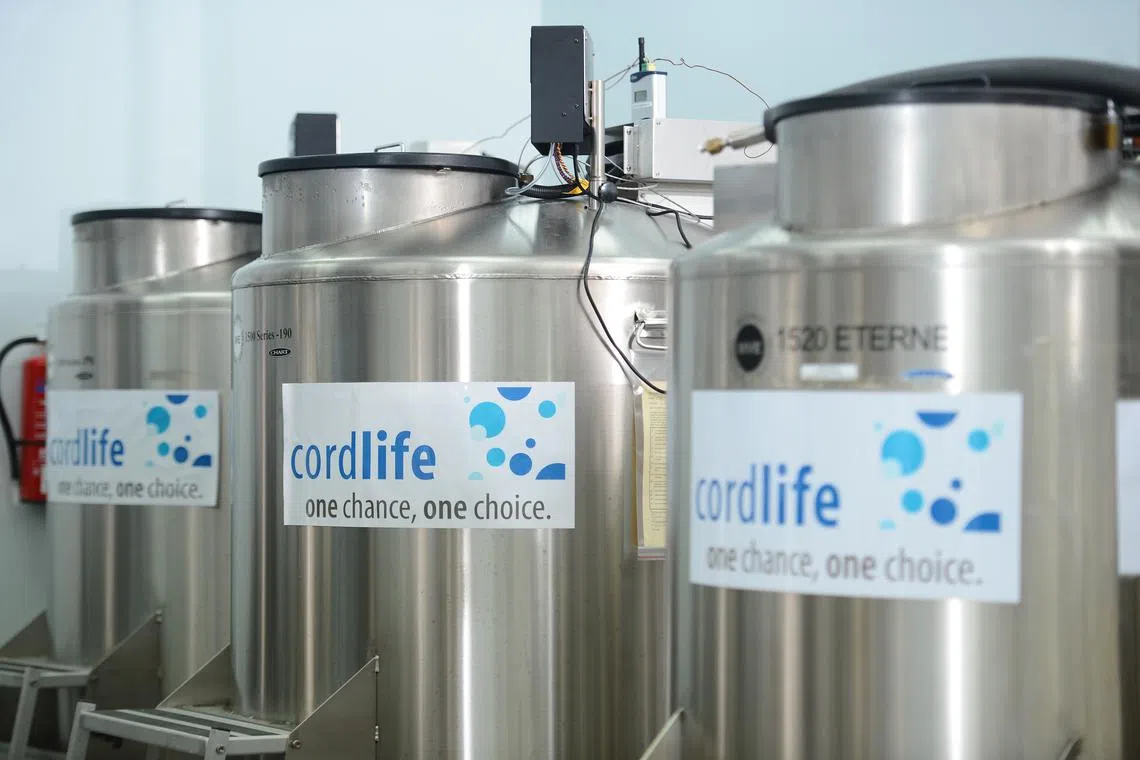Investigations into Cordlife Group expected to take about 6 more weeks: Ong Ye Kung
Sign up now: Get ST's newsletters delivered to your inbox

MOH said on Nov 30 that Cordlife Group had damaged cryopreserved cord blood units belonging to at least 2,150 clients.
PHOTO: CORDLIFE
SINGAPORE – Investigations into the viability of the cord blood units in six tanks at Cordlife Group are ongoing and expected to take about six more weeks, said Health Minister Ong Ye Kung in a Facebook post on Dec 8.
In the meantime, affected parents are advised to hold off on their requests for transfers to other cord blood banks, he added.
On Nov 30, the Ministry of Health (MOH) revealed in a statement that the private cord blood bank had exposed seven of its 22 tanks storing cord blood units
Cord blood units in one of its tanks, Tank A – which had an estimated 2,200 cord blood units belonging to approximately 2,150 clients – were damaged and are unlikely to be suitable for stem cell transplant purposes.
Mr Ong said he had received many e-mails and messages since the breaches were announced, and that many parents were understandably upset and distressed.
Other than ascertaining the extent of temperature changes for the six affected tanks and the viability of stored cord blood units within them, MOH is working to uncover the reasons for the breaches, said Mr Ong.
Parents had previously raised concerns about the viability of cord blood units housed in the other 15 tanks
In response to queries from The Straits Times, a Cordlife spokesman said the company will voluntarily initiate viability testing with an independent third-party laboratory of cord blood samples housed in all tanks, except Tank A. The six tanks that had temperature changes will be prioritised.
“The process to engage a third-party laboratory is under way and we will share an update on this as soon as possible,” said the spokesman.
Responding to parents who have requested MOH to facilitate the transfer of cord blood units banked with Cordlife to another blood bank, Mr Ong said the ministry has held discussions with other cord blood banks, which are prepared to help.
“However, we advise that parents hold off these requests for now, until the full impact of the breaches (is) known in a few weeks.
“This is because if a unit is assessed to be unaffected, and Cordlife can strengthen its processes, it may be riskier to make a switch given the logistical complexity of making a physical transfer,” said Mr Ong.
MOH is also working closely with Cordlife in the interim to address the company’s shortcomings.
“We are closely supervising their cord blood banking activities and inventory management. We will ensure that Cordlife implements effective processes to adhere to requirements under the Healthcare Services (Cord Blood Banking Service) Regulations and prevent similar incidents from happening in future,” said Mr Ong.
Beyond the immediate measures to protect the interests of the public and Cordlife’s clients, MOH will ensure that all relevant industry players learn from this episode, he added.
He also said that depending on the findings of MOH’s investigations, the ministry will follow up with the necessary regulatory and enforcement actions against Cordlife, given the severity of the breaches and the impact on clients.
“This is to ensure proper accountability, and to underscore the importance of industry players to adhere to the required regulatory standards,” said Mr Ong.
MOH will continue to keep parents updated, he added.
The company has been ordered to stop collecting, testing, processing and/or storing any new cord blood and human tissues for up to six months. It is also not allowed to provide any new types of tests to patients.
Cordlife has been given 14 days to make representations to the ministry.
Its spokesman said: “We are working closely with MOH and our conversations and meetings are ongoing during this 14-day period. We will be able to share more information once this investigation has been completed.”
Cord blood unit storage is a private service that has emerged over the last 20 years.
It is offered to parents when their babies are born. The cord blood contains stem cells known as haematopoietic stem cells, which may be used in stem cell transplants to treat blood diseases and some cancers, such as leukaemia and lymphoma, should the baby develop these illnesses later in life.
Cord blood may be donated to a public cord blood bank and made available to anyone who needs it.
Steps that the Health Ministry is taking
MOH is closely supervising Cordlife’s cord blood banking activities and inventory management, working with it to address shortcomings.
Discussions to facilitate the transfer of cord blood units to other cord blood banks have been held, but parents are advised to hold off until the full impact of the breaches is known.
MOH will ensure industry players learn from this episode.
Regulatory and enforcement actions may be taken against Cordlife, depending on the severity of the breaches and the impact on clients.


